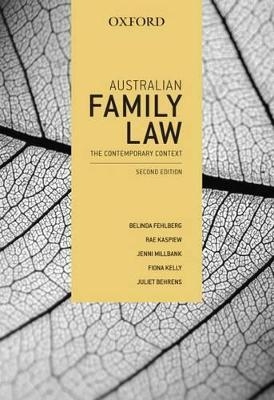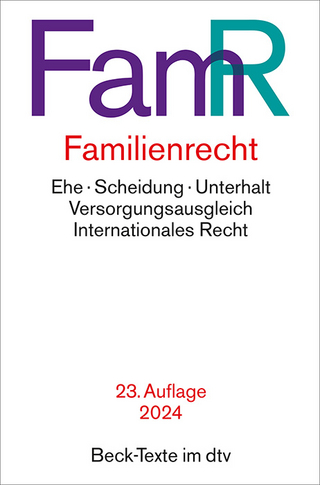
Australian Family Law: The Contemporary Context
OUP Australia and New Zealand (Verlag)
978-0-19-557433-3 (ISBN)
This second edition has been comprehensively updated to reflect the latest changes in family law. It continues to take a thematic approach, and its use of interdisciplinary materials presents the substantive law in a highly contextualised way. This new edition includes a separate chapter on financial disputes, and expanded coverage of parenting and property disputes.
Belinda Fehlberg - Professor, Faculty of Law, University of Melbourne Rae Kaspiew - Leading Australian Socio-legal Researcher, Family Law and Family Violence Jenni Millbank - Professor, Faculty of Law, University of Technology, Sydney Fiona Kelly - Senior Lecturer, School of Law, La Trobe University Juliet Behrens - Senior Associate, Dobinson Davey Clifford Simpson Lawyers
1. Introduction1.1 Introduction1.2 Themes1.3 Structure of the book2. Structural Fragmentation: The Constitutional Framework2.1 Introduction2.2 Family law and the Australian Constitution2.3 How have Parliament's powers been interpreted?2.4 Extending Parliament's legislative power3. Mechanics of Fragmentation: The Jurisdictional Framework3.1 Introduction3.2 The Family Court of Australia3.3 The Federal Circuit Court of Australia3.4 Jurisdiction of the federal family law courts3.5 Other courts exercising jurisdiction under the Family Law Act3.6 The future of the federal family law courts3.7 Case study: Jurisdictional overlap in child protection3.8 Conclusion4. The Legal Recognition of Family Relationships4.1 Introduction4.2 Recognition of adult partnerships4.3 Who is a parent4.4 Conclusion5. Family Violence5.1 Introduction5.2 Recent developments5.3 What is family violence?5.4 Scope, extent and the significance of context5.5 A spectrum of severity: Recent Australian evidence and implications for practice5.6 Children and family violence5.7 Family Law Act approaches5.8 Civil protection orders5.9 Conclusion6. Introduction to parenting disputes6.1 Introduction6.2 Gender roles and parenting in separated and intact families: Empirical evidence6.3 Legal concepts relating to parenthood in Part VII: An historical overview6.4 The contemporary Part VII framework6.5 United Nations Convention on the Rights of the Child6.6 Part VII: Current concerns6.7 Conclusion7. Processes for Resolving Parenting Disputes7.1 Introduction7.2 Sorting things out: Dynamics and issues7.3 Participation of children and young people7.4 Family Relationship Centres and other elements of the system7.5 Alternative Dispute Resolution in family law: Development and debates7.6 Court processes7.7 Ongoing support7.8 Conclusion8. Framework and Principles for Decision Making in Children's Matters8.1 Introduction8.2 Applying for parenting orders8.3 How are parenting orders made?8.4 The three-stage legislative pathway8.5 After court orders are made8.6 Conclusion9. Specific Issues in Parenting Disputes9.1 Introduction9.2 Shared time: What are courts deciding?9.3 Religion9.4 Aboriginal and Torres Strait Islander children9.5 Applications by people who are not parents9.6 Parental mental illness9.7 Disputes as to where a child will live9.8 Conclusion10. Introduction to Financial Disputes10.1 Introduction10.2 Understanding post-separation financial disadvantage10.3 Wealth sharing within intact families and on relationship breakdown10.4 Law and policy in relation to financial disputes on relationship breakdown: An overview10.5 Conclusion11. Child Support11.1 Introduction11.2 The CSS11.3 Formula assessment: Preliminaries11.4 The basic formula11.5 Flexibility in the operation and application of the formula11.6 Enforcement11.7 Child support after the 2006-08 amendments: research and evaluation11.8 FLA child maintenance provisions11.9 Conclusion12. Processes for Resolving Property Disputes12.1 Introduction12.2 How do separating spouses and de facto couples work out their property arrangements?12.3 Dispute resolution processes12.4 Mechanisms for giving effect to private agreement without commencing property proceedings12.5 Going to court12.6 Conclusion13. Legal Framework for Resolving Property Disputes13.1 Introduction13.2 Property division under the FLA: Preliminaries13.3 Identification of existing legal and equitable interests of the parties in their property13.4 Is it just and equitable to make an order?13.5 Identifying and assessing contributions13.6 Consideration of additional matters13.7 Is the result just and equitable?13.8 Orders in section 79/90SM proceedings13.9 After orders are made13.10 Conclusion14. Specific Property Issues in Property Disputes14.1 Introduction14.2 Allocating responsibility for financial losses and liabilities14.3 Initial and post-separation contributions14.4 Breadwinner contributions in high asset cases14.5 Superannuation14.6 Relevance of family violence to property outcomes14.7 Financial agreements: Not so binding?14.8 Conclusion15. Maintenance for Spouses and de Facto Partners15.1 Introduction15.2 Working things out?: empirical evidence15.3 Obtaining maintenance without going to court15.4 Going to court15.5 Legal framework: Two-fold threshold test15.6 Orders15.7 After orders are made15.8 Conclusion16. Conclusion
| Verlagsort | Melbourne |
|---|---|
| Sprache | englisch |
| Maße | 170 x 246 mm |
| Gewicht | 1234 g |
| Themenwelt | Recht / Steuern ► EU / Internationales Recht |
| Recht / Steuern ► Privatrecht / Bürgerliches Recht ► Familienrecht | |
| ISBN-10 | 0-19-557433-8 / 0195574338 |
| ISBN-13 | 978-0-19-557433-3 / 9780195574333 |
| Zustand | Neuware |
| Haben Sie eine Frage zum Produkt? |
aus dem Bereich


